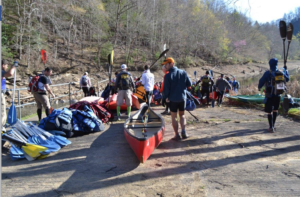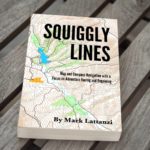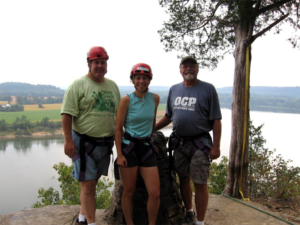by Jess Evans
March 13, 2018
“The FIG” in Red River Gorge, Kentucky, was my first adventure race and only race I did for several years. The FIG was a 12-hour adventure race that had been taking place since 2002. With the tough terrain and spectacular views, it is still one of my favorite races.
My first FIG was in 2010. I signed up as a solo-female. Unfortunately, I need to dig around in my memory to separate my past FIG races. They seem to jumble together. I think the race started with a bus ride to the trails on the east side of the highway, and ended in Beattyville. I remember in this race the rappel section was backed up and a young woman got her hair caught in the ATC, which prolonged the back up. I, along with a few other teams, decided to skip the rappel, hoping to find a safe route down. It was a bit sketchy climbing down, but we made it to the road below. Soon I was by myself again and trying to get up another ridge to a saddle where the next checkpoint sat. Much of that race is a blur, but I do remember getting to the finish before anyone else. The race staff was not even there yet! Because it was my first race, I was pretty cautious and cut out a lot of the checkpoints, fearing I would be late. Nope, I had to sit there and wait for everyone to show up.
I did at least one more FIG as a solo-female until, in 2012, Stephanie introduced me to two guys from Indiana racing under the name “Off The Map”. They were looking for a female racer to qualify for the USARA National Championships race. In those days only Co-Ed teams could qualify for the USARA National Championship race. I was so worried I would be slow and a terrible teammate. However, I had a great time with Robert and George, and we qualified for the 2013 USARA National Championship race in Brown County, Indiana. I never dreamed I would make it to the National Championships. Surely that was for far better racers than me! The best part about that race in 2012 was that I learned I really enjoy racing on a team, and I found a great racing buddy. I still race with Robert from time to time, when we can manage it.

 In 2015, I decided to join two friends on the Great Divide bike ride through the Rocky Mountains. All of us lived in Ohio (a measly 1,000 feet above sea level). The Great Divide starts in Banff, Alberta at about 4,800 feet above sea level and goes up from there. They arrived in Alberta on a
In 2015, I decided to join two friends on the Great Divide bike ride through the Rocky Mountains. All of us lived in Ohio (a measly 1,000 feet above sea level). The Great Divide starts in Banff, Alberta at about 4,800 feet above sea level and goes up from there. They arrived in Alberta on a 

 I will skip ahead about 10 years. I was at Otter Creek Park in Kentucky working in the Nature Center and the Recreation Department. I learned how to climb an alpine tower, belay, and rappel at the park and taught visitors how to do these activities too. It was a blast! In September of 2007, my supervisor announced that Stephanie, from Flying Squirrel Adventures, would be putting on an adventure race in the park, and I would be helping with the ropes section. I had no idea what an adventure race was, but it all sounded fun.
I will skip ahead about 10 years. I was at Otter Creek Park in Kentucky working in the Nature Center and the Recreation Department. I learned how to climb an alpine tower, belay, and rappel at the park and taught visitors how to do these activities too. It was a blast! In September of 2007, my supervisor announced that Stephanie, from Flying Squirrel Adventures, would be putting on an adventure race in the park, and I would be helping with the ropes section. I had no idea what an adventure race was, but it all sounded fun.